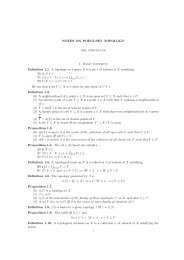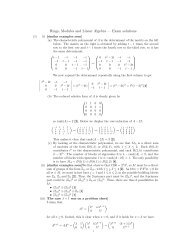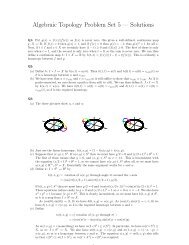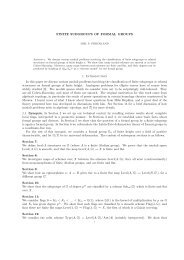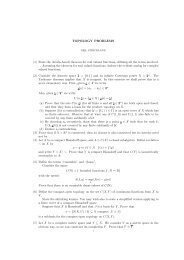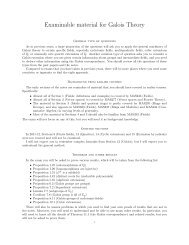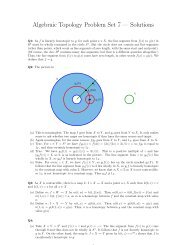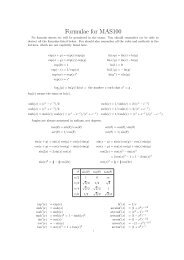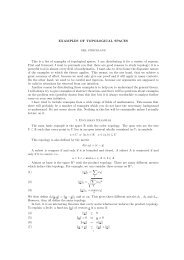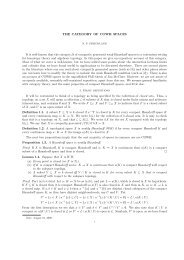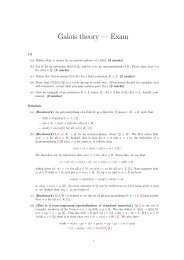Algebraic Topology Problem Set 6 â Solutions - Strickland, Neil
Algebraic Topology Problem Set 6 â Solutions - Strickland, Neil
Algebraic Topology Problem Set 6 â Solutions - Strickland, Neil
- No tags were found...
Create successful ePaper yourself
Turn your PDF publications into a flip-book with our unique Google optimized e-Paper software.
<strong>Algebraic</strong> <strong>Topology</strong> <strong>Problem</strong> <strong>Set</strong> 6 — <strong>Solutions</strong>Q1: First note that g ∗ f ∗ = (gf) ∗ = 1 X∗ = 1 π0X, so g ∗ f ∗ (u) = u for all elements u ∈ π 0 X.(a) Suppose that f ∗ (u) = f ∗ (v). Then g ∗ f ∗ (u) = g ∗ f ∗ (v), or in other words u = v. This showsthat f ∗ is injective.(b) Suppose that u ∈ π 0 X. If we put v = f ∗ (u) ∈ π 0 Y , we find that g ∗ (v) = g ∗ f ∗ (u) = u. Asu = g ∗ (v) we see that u is in the image of g. This holds for all u, so g ∗ is surjective.(c) Suppose that A = {a 1 , . . . , a n }. (We assume that this lists all the elements without repetition,so a i ≠ a j when i ≠ j, and |A| = n.) Suppose that j : A −→ B is injective. Thenj(a 1 ), . . . , j(a n ) are all elements of B, and they are all different because j is injective. ThusB has at least n different elements, ie |B| ≥ n. Suppose instead that q : B −→ A is surjective.Each element a i must lie in the image of q, so a i = q(b i ) for some b i ∈ B. If b i = b j then wemust have q(b i ) = q(b j ), or in other words a i = a j , but this only happens when i = j. Thisshows that b 1 , . . . , b n are distinct elements of B, so again |B| ≥ n.Q2:(a) Put u(t) = h(t, x) and v(t) = h(t, y), so u is a path from x to a, and v is a path from y toa. Then put w = u ∗ v, or equivalently{h(2t, x) if 0 ≤ t ≤ 1/2w(t) =h(2 − 2t, y) if 1/2 ≤ t ≤ 1This gives a path from x to y.(b) First put b = f(a) and h ′ (t, y) = f(h(t, g(y))). Then h ′ (0, y) = f(h(0, g(y))) = f(g(y)) andh ′ (1, y) = f(h(1, g(y))) = f(a) = b for all y. In other words, h ′ is a homotopy between fgand the constant map c b with value b. We are also given a homotopy k from 1 Y to fg, andwe can combine these to get a homotopy m: I × Y −→ Y between 1 Y and c b . Explicitly, theformula ism(t, y) ={k(2t, y) if 0 ≤ t ≤ 1/2h ′ (2t − 1, y) if 1/2 ≤ t ≤ 1.Q3:( ) a b(a) Suppose that A = . Thenc d( ) ( ) ( )a b 0 1 b aAM ==c d 1 0 d c( ) ( ) ( )0 1 a b c dMA ==1 0 c d a b( ) a bThus AM = MA if and only if c = b and d = a, so A has the form . If so thenb adet(A) = a 2 − b 2 = (a + b)(a − b).( ) a b(b) Put X = {A ∈ GL 2 C | AM = MA}. If A ∈ X then A must have the form withb a(a + b)(a − b) = det(A) ≠ 0, so a + b and a − b are nonzero. We can thus define a mapf : X −→ C \ {0} × C \ {0} by f(A) = (a + b, a − b). Note that if u = a + b and v = a − bthen a = (u + v)/2 and b = (u − v)/2. It follows that f is a homeomorphism, with inversef −1 (u, v) = 1 ( )u + v u − v.2 u − v u + v(c) As C\{0} is homotopy equivalent to S 1 , we deduce that X is homotopy equivalent to S 1 ×S 1 ,which is the torus.
2Q4:(a) The pictures are as follows:L + C CCH +CTLTH -The space L is star-shaped around (0, 0) and thus is contractible. The space L + consists oftwo disjoint lines, each of which is homotopy equivalent to a point. Thus L + ≃ S 0 . Thespace C consists of the two points (−1, 1) and (1, 1) so it is homeomorphic to S 0 , and hencehomotopy equivalent to S 0 . The spaces H and T each consist of two disjoint, contractiblecurves so also H ≃ T ≃ S 0 . The space H + is contractible.(b) The cone on the left is L, the half-cone on the right (which does not contain the origin) is L + ,and the black circle is C. For any point a ∈ L, the straight line joining a to 0 lies wholly inL, so L is again star-shaped and contractible. As the vertex has been removed from L + , wecan straighten it out to get a cylinder like S 1 × (0, ∞), which is clearly homotopy equivalentto S 1 . Also, C is homeomorphic and thus homotopy equivalent to S 1 .The picture on the left shows H, which consists of two disjoint surfaces, each one homeomorphicto R 2 and thus contractible. It follows that H ≃ S 0 and H + is contractible. Thepicture on the right shows T . Here the walls can be straightened out to give a cylinder




